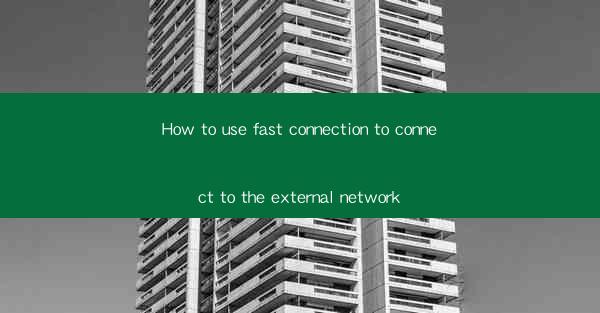
How to Use Fast Connection to Connect to the External Network
In today's digital age, a fast and reliable connection to the external network is crucial for both personal and professional use. Whether you need to access online resources, communicate with colleagues, or simply enjoy streaming your favorite shows, a high-speed internet connection is essential. This article aims to provide a comprehensive guide on how to use a fast connection to connect to the external network, covering various aspects to ensure a seamless and efficient experience.
Understanding the Basics of Fast Connection
Understanding the Basics of Fast Connection
To begin with, it is important to understand the basics of a fast connection. A fast connection refers to a high-speed internet connection that offers a significant amount of bandwidth, allowing for quick data transfer and minimal latency. This is crucial for activities that require large amounts of data, such as streaming videos, downloading files, or engaging in online gaming.
Factors Affecting Connection Speed
Factors Affecting Connection Speed
Several factors can affect the speed of your connection. These include the type of internet connection, the quality of your hardware, and the distance between your device and the network source. Understanding these factors can help you optimize your connection and ensure a faster and more reliable experience.
Type of Internet Connection
Type of Internet Connection
The type of internet connection you have plays a significant role in determining the speed. Common types of connections include DSL, cable, fiber optics, and satellite. Fiber optics, for example, offers the highest speeds and is considered the fastest option available.
Quality of Hardware
Quality of Hardware
The quality of your hardware, such as your router and modem, can also impact your connection speed. Outdated or low-quality hardware may not be able to handle high-speed connections efficiently, leading to slower performance. Investing in high-quality hardware can significantly improve your connection speed.
Distance from Network Source
Distance from Network Source
The distance between your device and the network source can also affect your connection speed. The further you are from the source, the weaker the signal and slower the connection. Ensuring a close proximity to the network source can help maintain a faster and more stable connection.
Optimizing Your Connection
Optimizing Your Connection
Once you have a basic understanding of fast connections, it is important to optimize your connection for the best performance. Here are some key steps to consider:
Updating Router Firmware
Updating Router Firmware
Keeping your router firmware up to date is crucial for maintaining optimal performance. Firmware updates often include bug fixes and performance improvements that can enhance your connection speed and stability.
Regularly Restarting Router
Regularly Restarting Router
Regularly restarting your router can help resolve connectivity issues and improve performance. This simple step can clear out temporary glitches and ensure a stable connection.
Using Quality of Service (QoS)
Using Quality of Service (QoS)
Quality of Service (QoS) allows you to prioritize certain types of traffic on your network, ensuring that critical applications receive the necessary bandwidth. This is particularly useful if you have multiple devices connected to your network.
Managing Bandwidth Usage
Managing Bandwidth Usage
Monitoring and managing your bandwidth usage can help identify and resolve issues that may be affecting your connection speed. By identifying devices or applications consuming excessive bandwidth, you can take appropriate actions to optimize your connection.
Troubleshooting Connection Issues
Troubleshooting Connection Issues
Despite your best efforts, you may still encounter connection issues. Here are some common troubleshooting steps to consider:
Checking Network Outages
Checking Network Outages
Before diving into troubleshooting, it is important to check if there are any network outages in your area. Service providers often have outage maps or customer support channels where you can check for any ongoing issues.
Resetting Router and Modem
Resetting Router and Modem
Resetting your router and modem can help resolve connectivity issues caused by temporary glitches or outdated firmware. This process involves pressing the reset button on your device and waiting for it to reboot.
Updating Device Drivers
Updating Device Drivers
Outdated device drivers can cause connectivity issues. Regularly updating your device drivers, especially for your network adapter, can help ensure optimal performance.
Conclusion
In conclusion, using a fast connection to connect to the external network is essential in today's digital world. By understanding the basics of fast connections, optimizing your connection, and troubleshooting common issues, you can ensure a seamless and efficient experience. Remember to keep your hardware up to date, regularly restart your router, and manage your bandwidth usage to maintain a fast and reliable connection. With these tips, you can enjoy the benefits of a high-speed internet connection and stay connected to the world.


